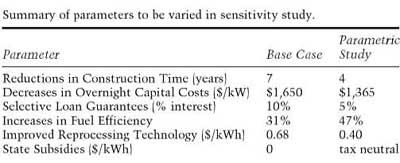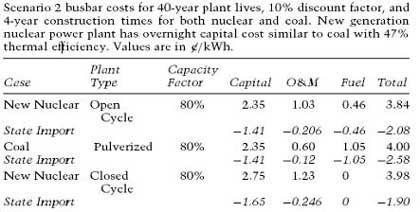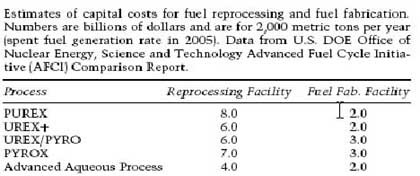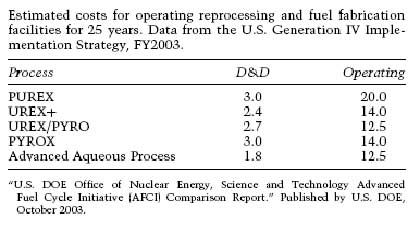|


|
 |
 |
nuclear power efficiency and reliability
|
|
|
|
| Is nuclear viable? |
|
Coal undoubtedly costs less than natural gas and has lower capital costs than nuclear. Hence it is recognised as a better long-term investment when compared to natural gas and a lower capital risk than nuclear.
Keeping though in mind that the recent climate change concerns are increasing rapidly, nuclear has now a second chance in realizing its potential firstly by decreasing capital costs from 5.26 $/kWh to 4.18 $/kWh, values closer to coal values, that is. In addition, increase of cycle efficiency could contribute in reducing further both fuel and capital costs.
When comparing coal to nuclear, discount rates, capacity factors and variations in year productions would be fairly close. A useful sensitivity analys is provided by J. Suppes and S. Storvick in Sustainable nuclear power focuses on parameters impacting mostly on nuclear power as shown in the following table. 6

Mittenkov et al. (2007) considered unifying the equipment and technological processes in order to reduce capital costs of building new nuclear reactors. Most effective solutions and organizational, technical as well as technological approaches utilised in developing the propulsion of nuclear systems should be adopted for the new nuclear power plants. 7
By standardisation and pre-approving of nuclear power plant designs, construction time could fall from 7 to 4 years. A 10% discount factor (interest rate) would produce a 14.4% decrease in levelised capital costs (reduction of 0.51c/kWh).
By improving reactor designs i.e. introducing technologies as the pebble bed, or the modular helium reactor SAIC, Scully, and EIA estimated that a 17.3% decrease in levelised capital costs could be achieved.
New generation nuclear power plants may succeed in increasing efficiency to 47%, slightly better than coal, with a cost advantage independent of plant life and discount factor. Results in the following table show that nuclear can cost less than coal. Moreover, up to 0.68 c/kWh in a cash flow going out of a state could be avoided when replacing coal with nuclear. This would actually mean a direct $54 m/ year /GW facility. 8

Apart from nuclear power's price being dominated by the costs relative to its construction and decommissioning (since fuel prices even of $300/kg would increase cost of nuclear energy by roughly 0.3 p/kWh), costs of uranium extraction could be further reduced by combining it in case of the sea with power station cooling through sea water.
Governments could support and stimulate new nuclear power plant designs by providing guaranteed loans that would offset the risk associated with new technologies and possible increased construction time. A loan guarantee corresponding to a corporation qualifying for a lower interest rate from 10 to 5 % during construction would decrease levelised costs by 18.1 %.
Currently, significant reduction of fossil fuels could only be achieved through the construction of a vast number of new nuclear reactors. A quite noticeable amount of land would be required which may be fairly small but in the case of the UK for instance the installation of a couple of reactors every 100 km roughly over the whole of the coastline 9 would hardly be accepted by a public largely concerned with important interruptions in the landscape, at least in the short run and until people get used to the idea.
When speaking of fuel reprocessing, one should bear in mind a cost difference between reprocessed fuel and new fuel of 0.22c/kWh (cost of closed cycle fuel in France at 90 c/kWh minus cost of once-through fuel in the U.S.at 68 c/kWh). This estimate is supported by the following table listing reprocessing facilities and fuel fabrication capital costs provided by the U.S. DOE. 10

Fuel cost for 25 years of operation, reprocessing and fuel fabrication are stated in the following table: 11

The above costs are actually inferior to those of acquiring new fuel. Nevertheless the U.S. Generation 4 Implementation Strategy, FY2003, achieves less sale credit in comparison to that of operating and D & D.
Reprocessing would be significantly supported by highly enriched uranium extracted from nuclear weapons. An agreement signed by the United States and the Russian Federation (1993) provided purchase of 500 metric tons of highly enriched uranium between 1993 and 2013. 12 If this uranium was accessible, fuel could be provided for the next 18 years with no requirement for new uranium to be mined or enriched.
|
|
Transportation is another field where nuclear energy could be greatly appreciated as the potential demand for electric power to replace petroleum represents roughly ¾ of the total current electricity demand. Presently there are nuclear supplies stockpiled in form of spent fuel or depleted uranium which could meet this demand.
A field which remains quite blurry is storage and disposal of radioactive waste. Although quantities are remarkably small compared to energy produced (IEA, 1995), in the US there is currently a serious concern regarding ways of disposing the 56000 tons of highly radioactive waste already piled up in plants across the country. Nuclear energy sustainability shall remain dependent on the capacity to reduce inventory and long term radiotoxicity of its waste.
As concluded by Ryhanen (2003), long term program and stepwise advancement have kept nuclear waste management costs down. Furthermore power plant areas have been considered to be useful places for storing waste with the infrastructure providing many benefits. 13
When it comes to costs, nuclear decommissioning in the UK for instance has an annual budget of £ 2000000 for the upcoming 25 years. Nuclear industry has made a deal for 4 kWh/d for this period, meaning the decommissioning authority's cost would be 2.3 p/kWh which is a rather big amount but small in relation to subsidies provided currently to offshore wind (7 p/kWh). 14 | |
 |
 |
|
| |
|
|
|
|
|
|
|

|
|
